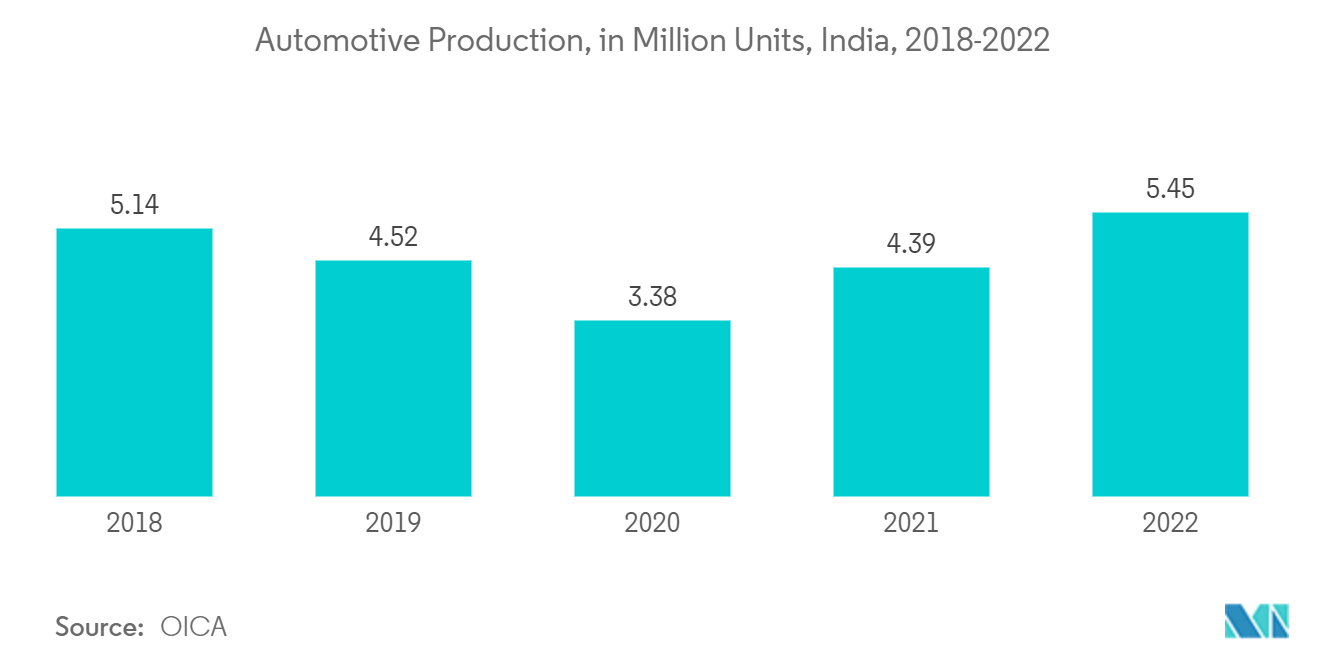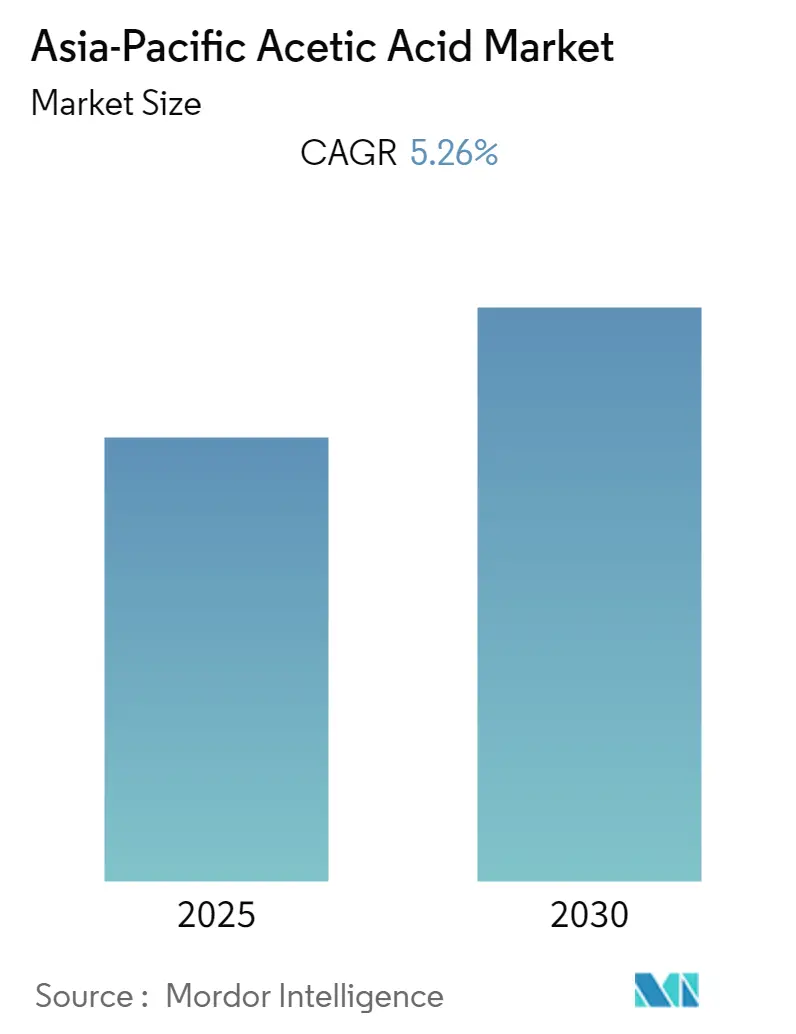
| Study Period | 2019 - 2030 |
| Base Year For Estimation | 2024 |
| Forecast Data Period | 2025 - 2030 |
| CAGR | 5.26 % |
| Fastest Growing Market | Asia Pacific |
| Largest Market | Asia Pacific |
| Market Concentration | Medium |
Major Players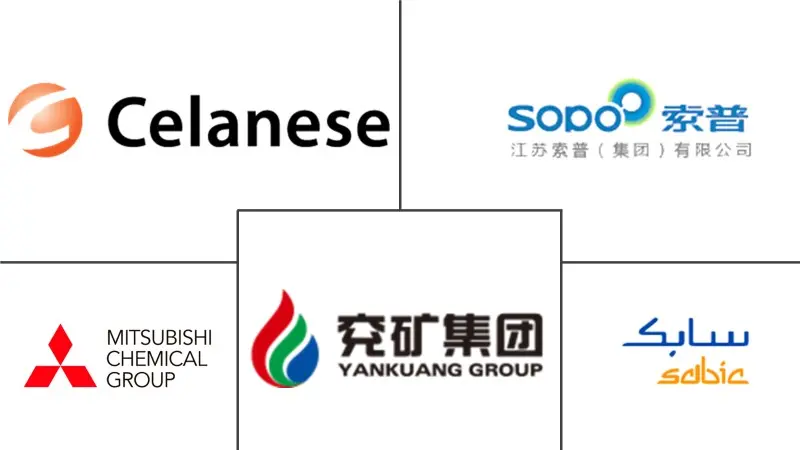
*Disclaimer: Major Players sorted in no particular order |
Asia-Pacific Acetic Acid Market Analysis
The Asia-Pacific Acetic Acid Market is expected to register a CAGR of 5.26% during the forecast period.
The COVID pandemic negatively impacted the Asia-Pacific region's acetic acid market. China, one of the largest manufacturers of acetic acid, had worst hit by the COVID pandemic, which resulted in production halts. However, Post-COVID, the market for acetic acid recovered due to increasing demand from end-user industries like adhesives, paints and coatings, and food and beverage.
- Over the short term, the increasing demand for vinyl acetate monomer (VAM), and the increasing demand from the paints and coatings industries, are some of the driving factors for the growth of the acetic acid market.
- On the contrary, environmental concerns regarding the harmful effects of acetic acid and increasing prices of raw materials have been hindering the growth of the acetic acid market.
- The development of new separation technologies to increase the production efficiency of acetic acid is expected to create opportunities for the market during the forecast period.
- China is expected to dominate the market. It is also expected to register the highest CAGR during the forecast period.
Asia-Pacific Acetic Acid Market Trends
Increasing Applications in the Adhesives, Paints, and Coatings Industry
- Acetic acid and its ester derivatives, such as ethyl acetate, butyl acetate, and vinyl acetate, are widely used in making adhesives, paints, and coatings. The acidic nature of acetic acid and its ability to dissolve polar and nonpolar compounds make it a useful ingredient in adhesives, paints, and coatings.
- In China, the demand for coatings is increasing in the automotive and construction industries. Thus several paints and coatings companies have been increasing their investments in the country. For instance, in July 2022, BASF SE expanded its automotive refinish coatings production capacity in Guangdong Province in South China.
- Similarly, in India, the demand for automotive and architectural coatings is increasing at a higher growth rate. According to OICA, in 2022, the production volume of motor vehicles in India reached 5.45 million units at a growth rate of 24% as compared to 4.39 million units manufactured in the previous year.
- Similarly in South Korea the demand for paints and coatings is increasing from automotive industries. In 2022, the production of automotive vehicles in the country reached to 3.75 million, registering the year-on-year growth rate of 9%, from 3.46 million units manfacturered in the previous year.The increase in the production volume of automotive vehicles is likely to drive the market for automotive adhesives and coatings.
- Thus, the increasing market demand for adhesives, paints, and coatings is excepted to drive the market for acetic acid in the region.
China is the Largest Market for Acetic Acid in the Region
- China is the largest market for acetic acid in the Asia-Pacific region. Acetic acid is widely used in greases, coatings, polyesters, and sealants, which have extensive applications in numerous industries, such as electronics, automobiles, textiles, and packaging. The extensive growth in these industries represents one of the major factors driving market growth in the country.
- China is known for its industrialization and manufacturing sector, where paints and coatings are widely required. Some of the major sectors where paints and coatings are used in the country are automotive, industrial, and construction, among others. China accounts for more than one-fourth of the global coatings market. According to the China National Coatings Industry Association, the industry has been registering a growth of 7% in recent years.
- The market demand for coatings is mainly driven by the construction industry in China. According to the National Bureau of Statistics of China, the output value of construction works in the country accounted for CNY 31.2 trillion (USD 4.34 trillion) in 2022, as compared to CNY 29.31 trillion (USD 4.084 trillion) in 2021. The growth of China construction industry is likely to continue, which is also expected to hold positive influence on the acetic acid market.
- The plastics industry in China has witnessed increased production outputs over the years, due to the growing demand for engineering plastics in high-end industries like automotive assembly and electronic manufacturing. There are over 15,000 plastic manufacturing companies in the country.
- China is the largest textile-producing and exporting country in the world. With its rapid growth over the last two decades, the Chinese textile industry has become one of the main pillars of the country's economy and contributes ~7% to the country's GDP. Low cost of production, high availability of labor, reduced commercial barriers, and material supply availability are a few of the competitive advantages the country offers for the clothing manufacturing industry.
- Therefore, the growth in the market for paints and coatings, plastics and textiles in China is also likely to drive the market for acetic acid in the country.
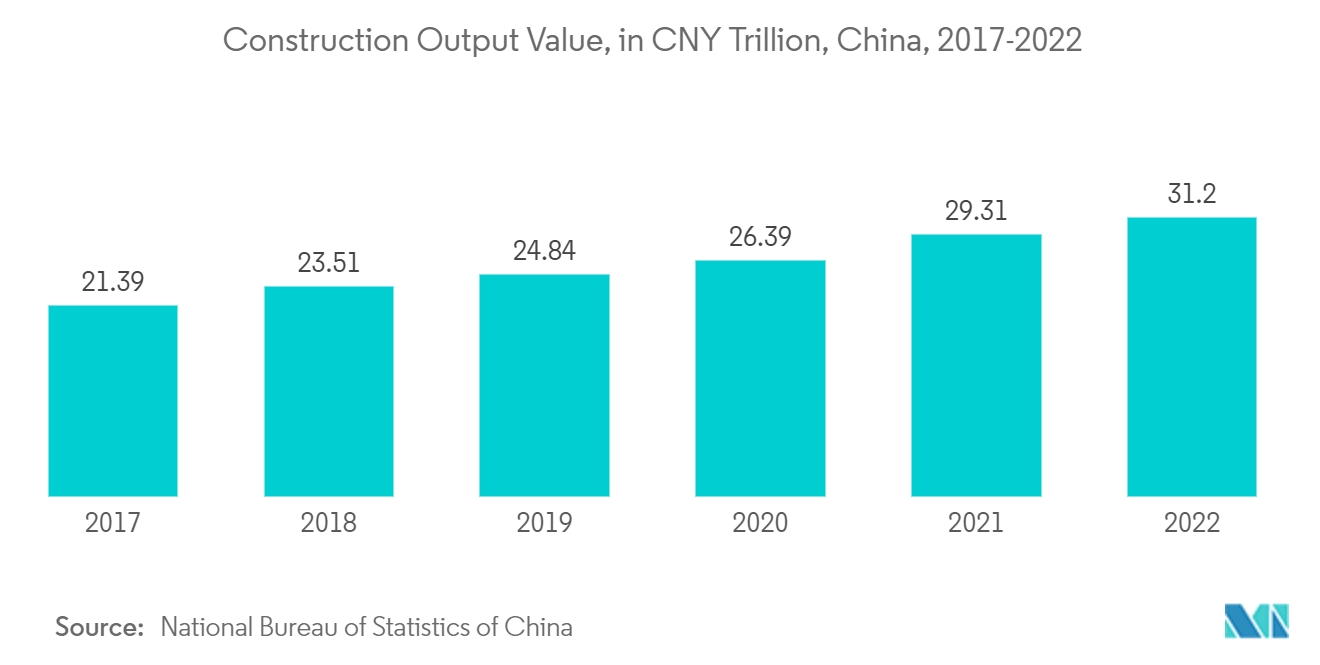
Asia-Pacific Acetic Acid Industry Overview
The Asia-Pacific acetic acid market is partially consolidated in nature. Some of the major players in the market include (not in any particular order) Celanese Corporation, Jiangsu SOPO (Group) Co. Ltd, Yankuang Group, SABIC, and Mitsubishi Chemical Corporation, among others.
Asia-Pacific Acetic Acid Market Leaders
-
Celanese Corporation
-
Jiangsu SOPO (Group) Co., Ltd.
-
Yankuang Group
-
SABIC
-
Mitsubishi Chemical Corporation
- *Disclaimer: Major Players sorted in no particular order
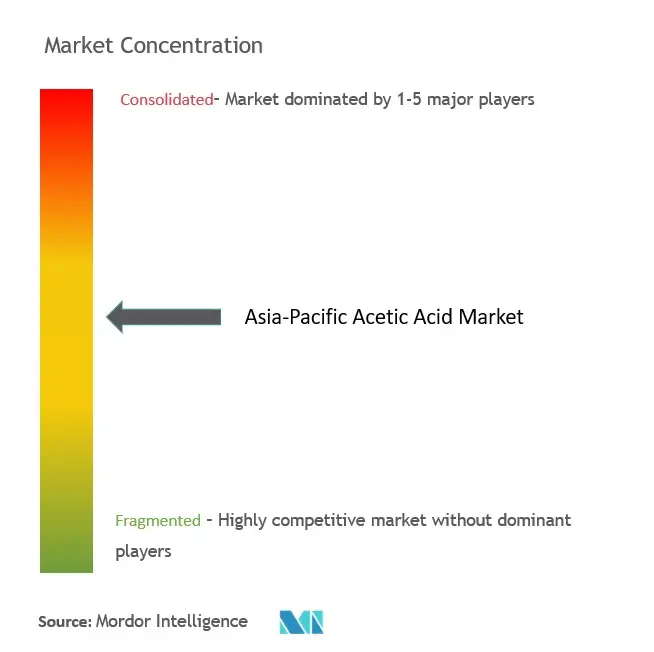
Asia-Pacific Acetic Acid Market News
- In April 2022, Jubilant Ingrevia Limited announced the commissioning of its new Green Ethanol based food-grade Acetic Acid plant at its manufacturing facility in Gajraula, Uttar Pradesh. The plant has a production capacity of 25,000 tons of food-grade acetic acid per annum.
- In March 2022, Anupam Rasayan India Ltd, a manufacturer of specialty chemicals (including acetic acid), acquired 24.96% of the stock shareholding of Tanfac Industries Ltd (TIL). The acquisition will help Anupam Rasayan India Ltd to further strengthen its position in India.
Asia-Pacific Acetic Acid Industry Segmentation
Acetic acid is a monocarboxylic acid containing two carbons. It is a clear, colorless liquid with a strong, pungent odor, like vinegar. Acetic acid can be derived from the carbonylation of methanol, the oxidation of acetaldehyde and ethylene, or a biological method like bacterial fermentation. It is used as a chemical reagent to produce several chemical compounds like acetic anhydride, ester, vinyl acetate monomer, vinegar, and many other polymeric materials.
The Asia-Pacific acetic acid market is segmented by derivative, application, and geography. By derivative, the market is segmented into vinyl acetate monomer (VAM), purified terephthalic acid (PTA), ethyl acetate, acetic anhydride, and other derivatives. By application, the market is segmented into plastics and polymers, food and beverage, adhesives, paints and coatings, textiles, medical, and other applications. By geography, the market is segmented into China, India, Japan, South Korea, Indonesia, Thailand, Malaysia, Philippines, Vietnam, Australia and New Zealand, and the Rest of Asia-Pacific. The report also covers the market size and forecasts for the acetic acid market in 10 countries in the region. Each segment's market sizing and forecasts are based on volume (million tons).
| Derivative | Vinyl Acetate Monomer (VAM) | ||
| Purified Terephthalic Acid (PTA) | |||
| Ethyl Acetate | |||
| Acetic Anhydride | |||
| Other Derivatives | |||
| Application | Plastics and Polymers | ||
| Food and Beverage | |||
| Adhesives, Paints, and Coatings | |||
| Textile | |||
| Medical | |||
| Other Applications | |||
| Geography | Asia-Pacific | China | |
| India | |||
| Japan | |||
| South Korea | |||
| Indonesia | |||
| Thailand | |||
| Malaysia | |||
| Philippines | |||
| Vietnam | |||
| Australia and New Zealand | |||
| Rest of Asia-Pacific | |||
Frequently Asked Questions
What is the current undefined size?
The undefined is projected to register a CAGR of 5.26% during the forecast period (2025-2030)
Who are the key players in undefined?
Celanese Corporation, Jiangsu SOPO (Group) Co., Ltd., Yankuang Group, SABIC and Mitsubishi Chemical Corporation are the major companies operating in the undefined.
Which is the fastest growing region in undefined?
Asia Pacific is estimated to grow at the highest CAGR over the forecast period (2025-2030).
Which region has the biggest share in undefined?
In 2025, the Asia Pacific accounts for the largest market share in undefined.
What years does this undefined cover?
The report covers the undefined historical market size for years: 2019, 2020, 2021, 2022, 2023 and 2024. The report also forecasts the undefined size for years: 2025, 2026, 2027, 2028, 2029 and 2030.
Our Best Selling Reports
Asia-Pacific Acetic Acid Industry Report
Statistics for the 2025 Asia-Pacific Acetic Acid market share, size and revenue growth rate, created by Mordor Intelligence™ Industry Reports. Asia-Pacific Acetic Acid analysis includes a market forecast outlook for 2025 to 2030 and historical overview. Get a sample of this industry analysis as a free report PDF download.



